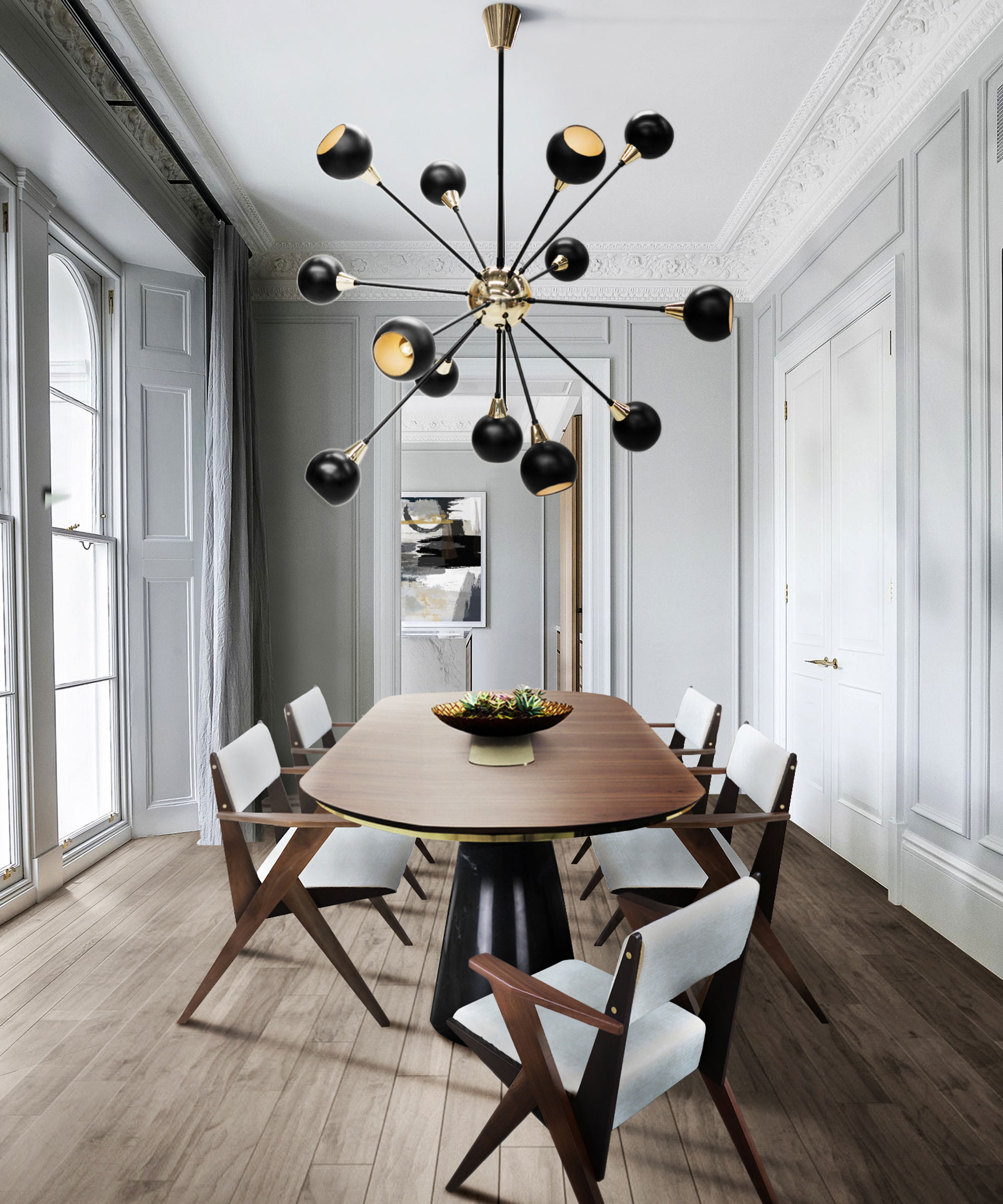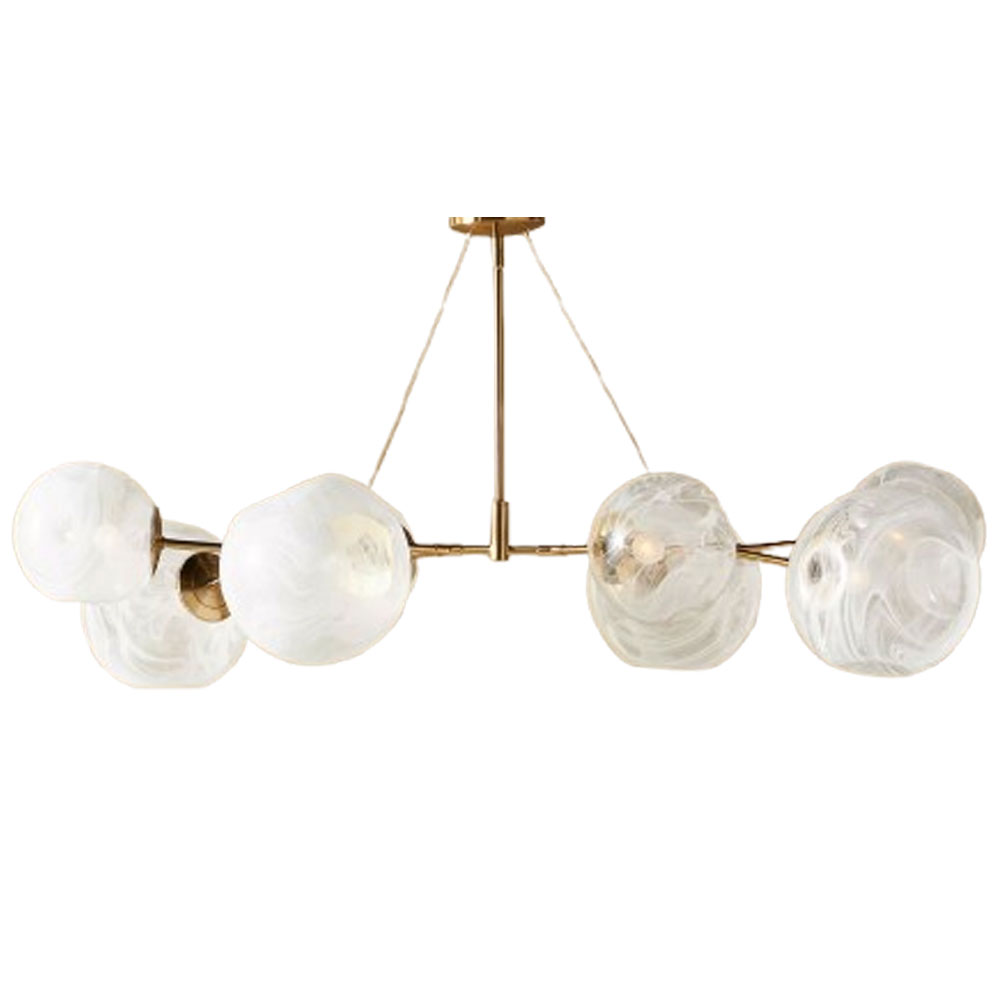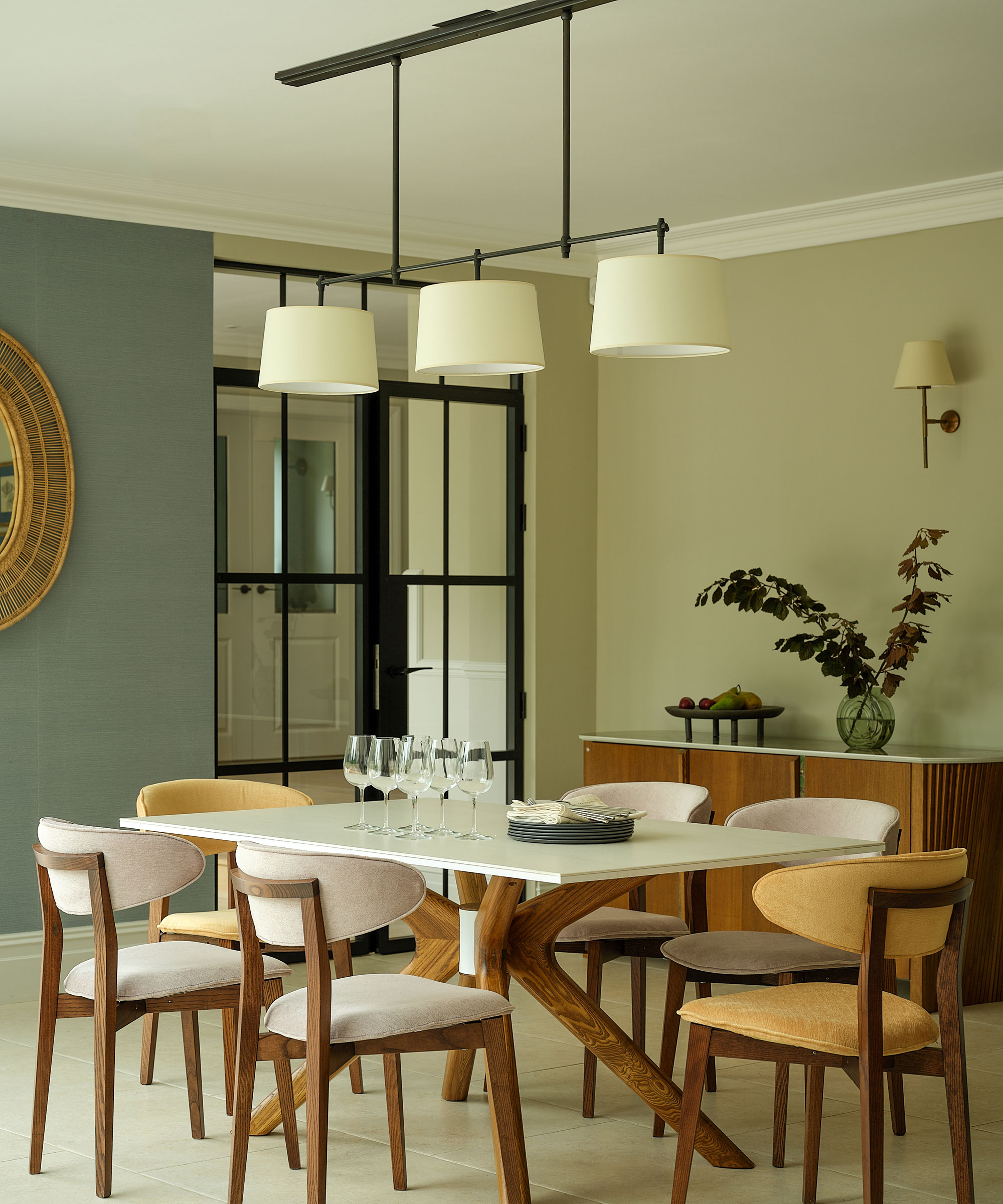How to Plan a Dining Room Lighting Scheme That Sets the Right Mood, Whether You're Dining or Reclining
Whether it's a sophisticated soirée or casual catch-up, the experts share how to design a lighting scheme to set the right mood


Planning dining room lighting needs some careful thought if you want it to be a space that works just as well for intimate soirees as it does relaxed family dinners.
"The dining room is a place that is no longer just a room to have meals, but somewhere that families gather, events are celebrated, or even quiet cups of tea get drunk," says George Crew, owner at Chicago Construction Crew. "This is why the lighting in this room is so important — for setting the mood and ensuring that this space is not only functional but also inviting."
Whether you need dining room lighting ideas for a formal space reserved purely for special occasions, or for a room in which the whole family frequents on a daily basis, our expert-led guide is here with all the advice you need to give it the glow it deserves. Here's what you need to know when planning your dining room lighting scheme.
1. Tailor the scheme to how you use the room
It's important to really spend some time thinking about how you plan on using your dining room, paying particularly attention to the activities that will take place in there most frequently — working from home, or carrying out a hobby, for example. From there, consider your hosting style and how your lighting could help enhance it.
"So much of the planning of dining room lighting fixtures has got to do with how the room is used," explains George Crew. "Is it just an intimate family dinner room, or does it also serve as work, homework space or a general entertaining room?"
Just as you would when looking into how to plan living room lighting, make a list of all the ways you intend on using this room and then think through what kind of light sources will work best. You'll need focused task lighting if you want to use it as a home office, as well as good, clear general background lighting.
2. Consider natural light sources

Not all dining takes place after dark, so do be sure to pay attention to how you can make the most of any natural light that might benefit this room. Daylight really does help foster a sense of wellbeing, and not maximizing it could be one of those lighting mistakes causing you stress.
"Don’t forget about natural light — it can be used to make a space feel more airy and open," points out George. "Strategically placed mirrors will reflect sunlight around the room, creating a spacious feel."
Take a look into the concept of 'daylighting' — it could just help you enhance the amount of natural light your dining room receives, whether through the position of your glazing or the finishes you choose on your walls and floors.
Simple things like ensuring one side of your dining table won't be facing glaring sunlight at certain times of the day (mainly mealtimes) will help ensure diners aren't squinting their way through lunch.
3. Start with a striking focal point

When it comes to selecting your lights, injecting a little drama into your dining room ideas never hurts — in fact, including one or two talking points is a great way to get dinnertime conversation flowing.
"Start with a showstopper — a chandelier or pendant light over the dining table is your pièce de résistance," says Blerta Morina, sales executive at Trade Warehouse. "Try something bold, like a modern geometric fixture or a classic candelabra-style light. Bonus points if it has dimming capabilities for those romantic dinners for two."
"Generally, it's the fixture that hangs over the table that is the centerpiece of most dining room lighting schemes," adds George Crew. "This is where you can actually speak up. Whether it be a chandelier, pendant lights or a modern linear fixture, this can set the trend of classic elegance, mid-century modern or minimalist chic."
A central, statement light fitting is a great place to start and you should build the rest of you scheme around this piece.

Price: $1,098
Sure to become the main topic of conversation during dinner, this striking chandelier exudes elegance with its marbled glass globes and champagne-finished frame.
3. Mix up your light types

Which brings us nicely on to the topic of layered lighting — something that really does benefit any room of the house. It's absolutely crucial when it comes to kitchen lighting design rules, but in the dining room, where the right ambience is key, it is also particularly important.
"Layering light is the key to a successful lighting scheme," confirms George. "Combining different types of light — ambient, task and accent — is known as layering, and gives you the ability to change the look and feel a space based on the job you’re doing."
"Dining room lighting is all about striking a balance between functional light for meals and softer, moodier light for ambiance," explains interior designer Victoria Holly of Victoria Holly Interiors. "The key is layering."
"Consider dining room lighting a three-course meal," says Blerta Morina. "You need variety to keep it interesting."

Price: $242.99, Was: $753.99
Make a statement at the same time as providing a good source of ambient lighting with this 13-light contemporary chandelier which throws light at all angles. The height is adjustable so you can tailor it to suit your table and room.

Price: $28.04, Was: $32.99
The beauty of this gold table lamp (apart from its obvious aesthetics) is that it's cordless, meaning you can take it anywhere, without having to consider power outlets. You can even style it on your dining table, and turn the 'big' lights off.

Price: $9.99
This roll of LED lighting not only makes it easy to highlight all kinds of features and spaces within a dining room, but it is also dimmable and can be set at 10 different levels of brightness — plus it has a timer function.
4. Use more than one ambient light source

A layered lighting scheme usually begins with ambient — also known as background or general — lighting. This is the light you'll rely on for all-over illumination and is provided by sources such as recessed downlights, pendants and even wall lights.
"One overhead light isn’t sufficient to bring you the ambiance or usefulness you need," warns George. "Ambient lighting should be added in such a way that it lights up the entire room equally. Recessed lights, or wall-mounted fixtures that fill in the gaps and stop the space from being overly shadowed, should be included.
"This is crucial, allowing you to set them each on dimmer switches to achieve the appropriate brightness for the occasion," he continues. . "A warmer and softer light feels great for a cozy dinner with friends, while brighter light might feel safer during a lively gathering, or a quick clean-up after getting the kitchen done."
With this type of lighting, if you are wondering how to make a lighting scheme feel cozy, you will want to combine it with other sources too.
5. Add personality with accent lighting

Accent lighting is a brilliant way to draw all eyes to certain decorative or architectural features in the room, adding a real sense of individuality to a space.
"You can add personality when you use accent lighting," explains George. "You could use wall sconces, picture lights or more subtle, focused lighting to bring attention to architectural features, artwork or even a statement wall. These touches make all the difference in the dining room, turning up the depth and visual interest."
Take a look around your dining room — could your fireplace benefit from a spotlight directed onto it, or would your newly-purchased piece of art be better appreciated under the glow of an adjustable picture light? Perhaps some hidden LED strip lights could bring your bookshelves to life?
The very pared back design of a lot of accent lights is perfect for those after minimalist lighting ideas.
6. Set the tone with the right light temperature

It isn't just the light fittings you use in the dining room that will contribute to the success of the space — light temperature matters almost as much.
"Dining room lighting should flatter your space and your guests — nobody wants to look like they’re in a dentist’s office during dinner," points out Blerta Morina.
Light color temperature is measured in Kelvins so be sure to take note of this when buying bulbs. "Warm white (2700K-3000K) is perfect for soft, flattering light," explains Blerta. "It’s like candlelight but without the wax drips."
"The dining room suits a warm and inviting tone," agrees George Crew. "Bulbs with a 2700K to 3000K color temperature produce a golden light that flatters both skin tones and food, and will help you create an inviting atmosphere. If you’re using LED fixtures, make sure to select high quality designs with great color rendering, as this will help bring out the colors in your room without making them seem overly harsh."
If you plan on making your dining room a multifunctional space, then you may need to include several different temperatures in order to match whatever is happening in the space at a particular time.
"Neutral white (3500K-4000K) is great for a multifunctional dining room," suggests Blerta Morina. "It is ideal for working on your laptop by day and hosting by night. Avoid anything too cool or blue — it’s not a dinner party if it feels like an interrogation room!"
You might like to consider using some color changing smart bulbs in this room rather than using lots of different lights — they are perfect for quickly altering the mood. This four-pack of Linkind Smart Light Bulbs from Amazon would work so well if you are just getting started with smart home tech.
"Color-changing LEDs are a solid choice — they let you switch between warm and cool tones depending on the time of day," explains Sergey Nikolin, president at Product Air Heating & Cooling LLC. "For example, warm lights are perfect for a cozy dinner, while cooler tones are better for a casual brunch. Think of the dining room as a dynamic space where lighting isn’t just functional but interactive."
7. Introduce some smart lighting solutions

If you are planning any kind of new lighting scheme within your home, you really need to be thinking about how smart systems could help. You don't have to spend thousands on a whole house automation set-up, even just a few smart bulbs can make the world of difference.
"Smart lighting is the dining room hack you didn’t know you needed," says Blerta Morina. "Picture this: you’re hosting a formal dinner, and with one command, the lights dim to warm, golden perfection. Then just switch to bright, clear lighting for the clean-up crew.
"Try Philips Hue Smart Bulbs from Amazon to change color brightness or set the mood with a tap," continues Blerta. "It’s lighting that does the heavy lifting while you take credit."
George agrees that smart lighting systems are an innovative "game changer" when it comes to planning your dining room lighting scheme. "They let you control the brightness of the light and the color of it, as well as the intensity," he says.
"What if you could turn a light up to a bright, daylight-like setting for a brunch and down to a dim golden setting for a romantic dinner with just the push of a button?" continues George. "Some systems even allow you to program preset lighting scenes so your dining room is always ready for the party."
To make the most of your smart lighting, take time to look into where to put LED lights for maximum effect.
8. Add in lamps for atmosphere and flexibility

It isn't just the more 'fixed' light sources, such as wall and ceiling lights, that should make up your dining room lighting scheme — fittings that you can move around the space depending on the mood or occasion you are trying to accommodate are just as important here.
"Increasingly, people are layering in table lamps and floor lamps in place of or to supplement overhead lighting," advises Tom Simon, design and product development manager at Juniper Design. "This approach, called 'horizontal lighting,' places light sources at eye level, creating a more flattering effect. Unlike direct overhead lighting, which casts unflattering shadows on the face, horizontal lighting provides a warm glow that enhances facial features."
Table lamps are currently big news in the world of kitchen lighting trends, so be sure to include some in this space too. This is also a great option for those who may have made a mistake in their dining room lighting plan, and want to find ways to introduce more light without having the re-wire the room.

Price: $78
Portable, battery-powered table lamps are so useful in the dining room as there are no trailing cables to deal with. We love the subtle design of this one, which also manages to inject a little warmth with its brass-toned base.
FAQs
What is the rule of thumb for lighting over a dining table?
One of the most important considerations when lighting a dining room is how to ensure the table is lit just enough, in a way that allows you to see the food and your plate, without feeling overly harsh.
"What matters is the size of the fixture — too small and you might lose the light, too large and you might overwhelm the space," explains George Crew. "A good rule of thumb is to match the fixture's width to about half to two thirds of the width of your dining table."
In terms of light height over dining tables, Sergey Nikolin has some handy advice. "Install lights 30–36 inches above the table surface to avoid glare while maintaining an intimate feel," he advises.

Price: $119.99
Can't decide on a height for your dining table light? Not a problem with this industrial style pendant that works on a weighted pulley system that allows you to adjust it between 23" - 121".
How to choose a light for a dining room?
There are no hard and fast rules when it comes to choosing the right lights for a dining room, but if you can aim to reflect the overall decor style, as well as the form of the pieces of furniture you have used in the space, you will be well on the way to a visually pleasing scheme.
Billiard lighting is particularly popular at present, but rather than being a slave to trends, opt for something based on your space.
"Choose fixtures that match your decor and fit the table's shape," suggests Dara Greaney, CEO and founder at LED Light Expert. "Rectangle lights for long tables, and round for more square or circular tables."
Should dining room chandelier lights face up or down?
Some chandeliers are fitted with bulbs that shine upwards, towards the ceiling, while others do the opposite, shedding all of their light down — but which is best in the dining room?
Upwards facing chandeliers focus all their light on the ceiling which results in a soft, background glow — perfect in living rooms or over the bed, but perhaps not as practical in a dining room.
In this case, a chandelier which shines downwards makes more sense, illuminating the table around which everyone will be gathered and perfect for the sociable dining table trend.
How many lights should you have over a dining table?
This totally depends on the size of your table as well as the type of lights you choose. An over-sized pendant, slung low over the table, will probably suffice, but if you have been drawn to the design of some daintier fittings you may well need more than one to ensure the entire table benefits.
"If you have a particularly large table, you could consider two smaller pendants instead of one large piece to keep things balanced," says Victoria Holly.
"If you’re after a modern look, go with modular or magnetic track lighting systems," suggests Sergey Nikolin. "They’re super flexible as you can easily move the fixtures around to fit table extensions or change up the room layout. Paired with wireless controls, they add flexibility that fixed lighting can’t achieve."
What to do if your electrical outlet isn’t centered directly over the table?

It can be really annoying when the outlet for the light you want suspended over your dining table doesn't match its center — but there are several solutions to consider.
The first is 'swagging' the light. You basically instal a 'swag hook' where you want the light to hang before looping the pendant's cable or flex, over the hook in a way that it dangles just where you want it.
Alternatively, you could install a light fitting with a rectangular canopy (as in the example above). This makes it possible to conceal the junction box within giving the appearance of a central light.
You could, of course, look out for some overhead lighting alternatives instead.
Inspired to get your hosting underway? Check out the things people who love entertaining always have in their homes to help you on your way.
Be The First To Know
The Livingetc newsletters are your inside source for what’s shaping interiors now - and what’s next. Discover trend forecasts, smart style ideas, and curated shopping inspiration that brings design to life. Subscribe today and stay ahead of the curve.
Natasha Brinsmead is a freelance homes and interiors journalist with over 20 years experience in the field. As former Associate Editor of Homebuilding & Renovating magazine, Natasha has researched and written about everything from how to design a new kitchen from scratch to knocking down walls safely, from how to lay flooring to how to insulate an old house. She has carried out a number of renovation projects of her own on a DIY basis and is currently on the lookout for her next project.
-
 My 10 Favorite Designs at Milan Design Week 2025 — Out of the Hundreds of Pieces I Saw
My 10 Favorite Designs at Milan Design Week 2025 — Out of the Hundreds of Pieces I SawThere is a new elegance, color, and shape being shown in Milan this week, and these are the pieces that caught my eye
By Pip Rich
-
 Iridescence Is Chrome’s More Playful, Hard-to-Define Cousin — And You're About to See It Everywhere
Iridescence Is Chrome’s More Playful, Hard-to-Define Cousin — And You're About to See It EverywhereThis kinetic finish signals a broader shift toward surfaces that move, shimmer, and surprise. Here's where to find it now
By Julia Demer